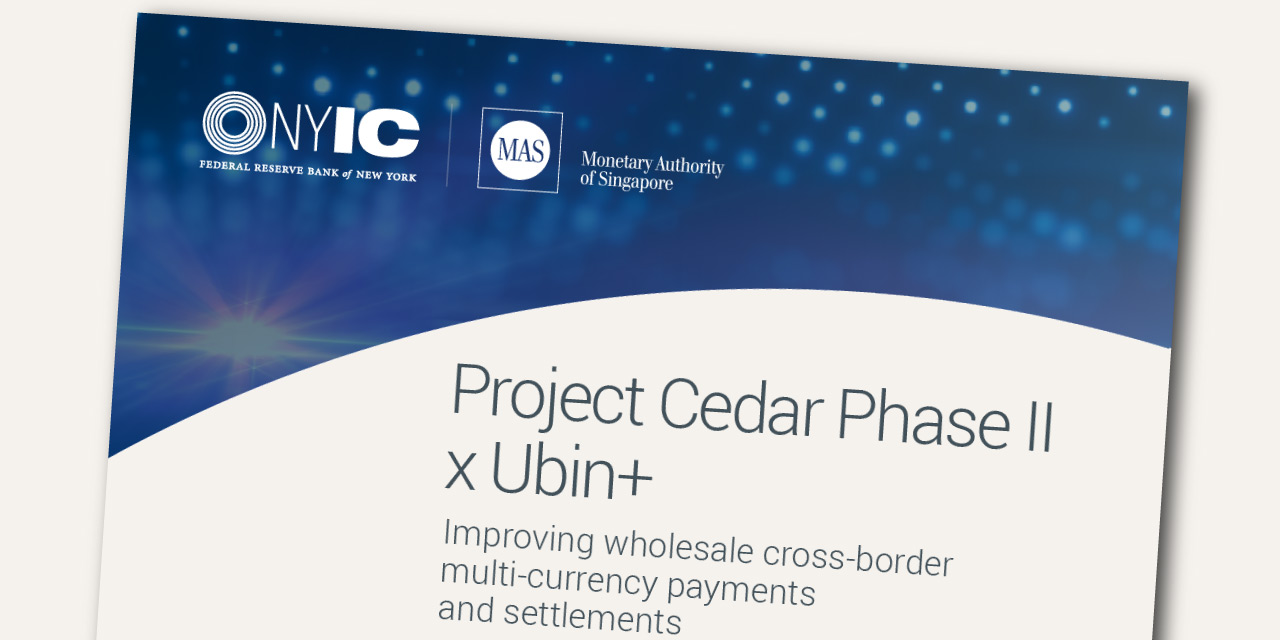Project Cedar is the inaugural project of the New York Innovation Center (NYIC). It is a multiphase technical research effort evaluating the potential applications of financial technology solutions to improve the efficiency of wholesale cross-border payments.
NYIC and the Monetary Authority of Singapore partnered on Cedar x Ubin+. This joint research experiment examined a cross-border multi-currency use case in which vehicle currencies are used as a bridge to exchange currency pairs which are not widely traded. It explored the ability of distributed ledger technology (DLT) to establish connectivity across heterogeneous simulated currency ledgers, reduce settlement risk, and decrease settlement time.
Cross-border payments support the functioning of the global economy enabling trade, commerce, and finance that support global value chains.
Many cross-border payments are also cross-currency payments, requiring a foreign exchange (FX) trade to convert the currencies and execute settlement processes in both the originating and beneficiary jurisdictions.
Cross-border payments face significantly greater challenges of high costs, low speed, limited access, and low transparency than domestic payments.
To address these challenges, Cedar x Ubin+ explored the interlinking of distinct central bank currency ledgers via hashed timelock contracts (HTLCs). HTLCs are time-bound smart contracts that act as bridges between ledgers based on distinct technologies, allowing for atomic settlement of digital assets that are maintained on different ledgers and/or are operated by distinct parties.
To test the viability of this model, the use case considered an end-to-end payment chain consisting only of settlement in central bank money in the form of wholesale CBDCs. Commercial banks maintaining accounts with multiple central banks act as intermediaries to facilitate atomic settlement across an end-to-end payment chain for an illiquid currency corridor.
The Cedar x Ubin+ experiment demonstrated that DLT could support enhancements to cross-border multi-currency payments and settlements.
- Interoperability and Autonomy: The experiment interlinked the distinct simulated central bank currency ledgers, providing flexibility in the design and operation of each ledger to the respective central bank. This enabled payments to be safely executed across multiple ledgers without the need for a central clearing authority or the establishment of a shared central network.
- Atomic Settlement: The simulated payments were settled atomically, meaning transactions were only settled if all legs in the cross-currency payment chains were executed successfully. This improved the certainty of settlement, addressing existing pain points such as counterparty risks.
- Near Real-Time Settlement: Each simulated payment scenario achieved end-to-end settlement in under thirty seconds on average. This enabled participants to be notified of a payment’s success in a matter of seconds.
In Phase I of Project Cedar, a prototype for a wholesale central bank digital currency (CBDC) ledger was developed to demonstrate the potential of blockchain to improve the speed, cost, and access to a critical element of the wholesale cross-border payments market—a foreign exchange (FX) spot transaction.
Wholesale cross-border payments are financial transactions between central banks, private sector banks, corporations, and other institutions based in separate jurisdictions. FX spot trades are among the most common wholesale cross-border payments, as they are often required to support broader transactions, such as for international trade or foreign asset investment.
Phase I of Project Cedar simulated a wholesale FX spot transaction, using a wholesale CBDC ledger prototype to test whether blockchain technology could deliver faster and safer payments. Core to the Project Cedar Phase I solution concept was the distributed ledger infrastructure—a multi-ledger construct in which each currency was maintained on a separate ledger, operated by its respective simulated central bank.
Project Cedar showed that blockchain could enable faster, simultaneous, and safer cross-border payments.











